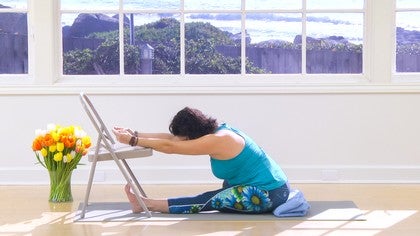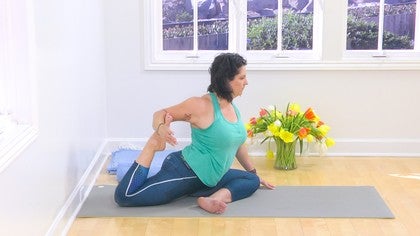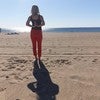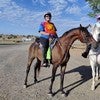Description
About This Video
Transcript
Read Full Transcript
Namaste, welcome to Cooling the Senses. Doesn't that sound delightful? So often times I'm told that this class is really good after a super hectic day when things are really fiery. Do you get fiery during the day? And then the fire kind of peters out and then you're really, really tired.
This practice is designed to create a balance within you. It's totally fine to do in the morning time. And doing in the afternoon or evening after you get home is going to give you the energy that you need to finish out the rest of your day, but it's going to cool the nervous system. So I hope you enjoy it. You will probably like to have a chair, we'll need one toward the end of class, and some of you may use the chair throughout the class, a block and a blanket.
Now the blanket is designed to create the front hip points to be a little bit higher than the knee points. So if you're sitting and your knees are like this, then the spine has to work so hard and you really, it's a lot harder to sit upright. But when you elevate the pelvis, watch, I'm going to elevate a little bit more. You elevate the pelvis. Now the spine doesn't have to work so hard.
And what does that mean? That means that your system's going to be at a state of ease, which is the point of Cooling the Senses, right? Now along with this practice, we're going to be using a hand mudra. If you're not familiar with that word, go back and look at what is a mudra, a little explanation on the show. But I'll show you what it's going to look like today.
You're going to take your thumb and you're going to join the middle finger and the ring finger together, just like this. And as I said in the intro to the mudras, it's a very light contact and there's a little bit of a roundedness to the fingers right here. There's a little roundedness, right? So you're not really making like a little coyote face. You're sort of making like a little rabbit face.
It's just like that. And then there's a quietness in the hands. So what Apan mudra does is it begins to allow the nervous system itself to unwind. It is a revitalizer and a restorer, an equalizer of sorts, right? Now when you rest your hands on your lap, you want to make sure they're not too far forward.
You're going to draw the hands back so that the elbows dropping right out of the shoulder. This will be the position of the hands to start. So go ahead and do that. Let's just kind of get a feel for what that feels like. Make sure you're not pinching, right?
It's just like a kiss. It's like this little sweet kiss of the fingers. The other fingers extend and over time they'll get better and better at extending from a relaxed state. So don't harden the hands and harden the fingers to get them to extend. Just ask them, I want you to extend as much as possible without getting too fiery because we are cooling, right?
Okay, so I'm going to turn this way and bring my chair around because I'd like for you to see what it will be like to use the chair. I'm going to stay elevated. I think that's really a benefit to everyone. And you don't need a special yoga chair. These are nice.
They don't have a back in them, right? But having a chair of any kind, like a house chair, allows you to fold forward with assistance if you need it. Now if you already know that you're quite flexible folding forward, then you probably don't need the chair, but you'll probably want it toward the end of class for something special that we'll be doing at the end of class. So let's begin. Your hands are on your lap.
Go ahead and turn them over and go ahead and take up on mudra, right? You're taking up on mudra and you're allowing the breath to get centered. For a moment, close your eyes. Feel the breath moving in and out of the body. You may be able to tell that you can feel one hand more than the other, that's super common and kind of neat.
Now allow your eyes to open and we're going to begin with the very first of the movements. And these are going to involve twists. So this particular sequence is enlivening to the liver along with the hand mudra. It's also calming. It's quite interesting.
So I'm going to elongate my spine, get it nice and tall, as tall as I can, and turn myself to my right. This hand is going to release the mudra and steady itself. This hand is going to rest on the lap. Always always I'm feeling like I'm taking a lid off of the jar. So there's an unwinding feeling as you're moving into the twist.
You can have a little tone to the lower belly. It helps to give a little stability to the back body. And here's what gets fun. As you unwind, take that back hand back into up on mudra, move to the other side. This hand opens and you're lifting and turning again with the sense that the lid is coming off of the jar.
Just pay attention to, not only to the breath, but where the tightest places in the body are. And as I'm moving into this twist, my lower belly is toned. I'm not working aggressively. I'm working very, very sweetly. Coming back to center, both hands go back to up on mudra.
Take a moment, close your eyes. Take a breath. Now allow the hands to open. Coming in and out of this mudra during the postures is part of the revitalizing aspect of it. If you're going to use a chair, you'll use a chair just like this.
Just a gentle forward fold. I'm letting my tailbone lift just a little bit. I'm letting my belly go soft. If you feel like, oh, this feels kind of high, I think I can go lower, then go ahead and go lower. Go right up under the chair and just fold yourself forward, taking a few breaths here.
If you want to venture into it without looking at your hands, can you put your hands into up on mudra? If the thumb touches the ring finger and the middle finger, a few breaths here. You release the mudra softly, walk your hands back or pull your hands off the chair. Come back to sitting. Now let's straighten the legs.
You're going to straighten the legs right up under the chair a little bit. Some of you probably can hyperextend. What hyperextend means is the knees can actually buckle backwards a little bit. It probably doesn't even bother you. We want the energy to be moving through the legs evenly.
It's sort of like kinking a straw. When you kink a straw, you can't get as much through the straw. If you know that you have that habit, what I'd like you to do is consciously allow your legs to be straight. Don't let them drop. If it seems a little bit like too much work today because you've had a long day, take a little towel and you can put it under there.
From here, we're going to take our hands to up on mudra. Rest the hands on your lap for a moment and get a feel for that. I am touching the sides of my feet. Only do that if that feels comfortable to your hips. If having your legs all the way together makes your hips cranky, go ahead and separate them.
We're cooling the senses. If you're aggravating the nervous system and aggravating the senses, they're going to fire up. Here we are. We're going to move into the twist again. The crossing hand is going to remain in mudra.
The other hand is going to come out of the mudra and it will be my support that helps the spine to lengthen. I move into the twist. Particularly with twist, I want you to notice your eyes and keep the eyes feeling soft like they're dropping back into the head. As we unwind back to center, the back hand is going to go into mudra all the way around and the front hand is going to go back behind, again reaching up. The turn of the head is not nearly as important as the feeling of the spine moving from the base of the spine around.
Remember the lid coming off the jar. Particularly if today my neck were stiff, I might even look at my feet. That is going to bring you to a state that feels calming and quiet. Notice the eyes. Have you ever seen anybody with their eyes bulging out?
Like it's kind of fiery looking in it. Don't do that. It's soft in your eyes. Back to center, back to the mudra for a moment and then release the mudra of the hands and begin to fold yourself forward. Again with the forward fold, you can kind of modify your chair, what's going to work for you.
If this position feels good, then you'll be here. If you think you know this doesn't really feel like I'm really forward folding very much, then what you'll do is you'll take your block and separate your legs a little bit. You can take your block and fold like this. Or maybe like this. I like this one.
If you can get your head to the block, well then you're a block head, but you can do that anyway. Just like this. But only if it's not too intense. If it's too intense and what's happening, it's like the nerves across sandpaper. They're firing up like a match strike.
No match strikes. Maybe the hands can go back into up on mudra without looking at them. The combination of the forward fold with the mudra is amazing. In the mudra, bringing yourself back up, put the block to the side. I'm going to bring the chair a little closer.
Now we're going to take one of my favorite poses. This is Baddha Konasana. And a lot of times with Baddha Konasana, you don't have to sit as high as you're sitting. So if this feels like you're falling too far forward, you're going to take the blanket down a little bit. Then we go to Appa Mudra.
This is just like I've said before, like plugging in your cell phone. The minute that comes together, it's like, it starts to feed it in. All this restoration, all this reclaiming, all this nourishing to the system is amazing. And so simple. So simple.
There we go. We're twisting again. So I'm turning. The back hand is always a support hand, so you have to take it out of mudra, lifting, turning from the base of the spine, deciding where does my neck need to be so that it feels good. Now the leg that I'm turning towards remains stationary.
And the leg that I'm turning away from is the leg that I actually am pressing. I press that leg as I lift up. So it's this outer leg that I'm pressing that's helping to create more of a stability in the pelvis and to reach in the spine, soft eyes. Unwinding back to center. Here we go to the other side.
Lifting and opening, turning and breathing. And there's a little period of waiting. So you go right to the place where it feels good, but no further than that, and then you wait and that area will, even that area will soften. Now the leg that I'm turning away from is the leg that presses a little more diligently. Coming back to center, back to mudra.
And to forward folding. So if you're using your chair, you can fold this way. I love to rest my forehead on my arms. It's soft, it's warm. You know it's pliable, the muscles are pliable, makes a nice rest for the head.
You can extend the arms and rest the head on the chair. Sometimes the cool surface of the chair feels really good. And then some of you will find that it's just fine to fold forward. But if the head doesn't reach the ground, then you're gonna stack the fists or the arms. Bring yourself up.
Hands to up on mudra. And then bring the knees together. As you bring the knees together, we're gonna take the legs straight ahead. If they're tucked under the chair, just be advised, we're about to widen the legs. Now in this position, I don't want you to widen the legs as much as possible.
Because what is that gonna do? That sort of fires everything up. I want you to widen the legs to a place that feels comfortable for you. And you're gonna sit very on the edge of the blanket so you feel a little bit like you're tipping forward. Sitting upright into the chest.
You've had some nice twists to bring some vitality to the liver and to the gallbladder. Helps to massage the stomach as well, gets us ready for a nice meal. Anchoring the heels, feeling the length of the spine, feeling quietness in your eyes. And then let's bring the legs back together. Tucking my hands behind me, I'm just gonna lift the chest, lean back into my hands.
Now you could stay on your fingertips, it's fine to stay on your fingertips, or you can flat palm and reach the chest, but keep your head forward please. Don't take the head back. There's a reason for that. When we take our head back, we're taking our spine into a really full-fledged back bend. And that can be very, actually very heating.
We need some extension, of course, because we just came out of the twists and the forward folds. So now we're gonna move to Janasur Shasana. In Janasur Shasana, bend your right leg and nestle it into the left leg. Remember your hand mudra, take the hands to up on mudra. And just wait here, you can rest the hands on your lap.
Moving more and more into quietness, we're moving into this forward fold, so beautiful. So the hands can remain in up on mudra, and just rest your arms on the chair. So we're not twisting anymore, but we're keeping a little more activity in the arms and legs. And that's gonna serve us well when we finally go to our restoring posture at the end of class. Of course, if you can fold deeper, fold deeper, but don't fold so deep that there's an extreme amount of sensation.
That won't serve you. Inhale and bring yourself up. Exhaling the right leg, see if you can hold your mudra, challenging you on every angle here. Open, close, hold, stop, full forward now. Second side.
Little more activity in the legs, little more activity in the arms. Inhale, back to straight legs, rest your hands on your lap. Reach the chest. Release the mudra. And let's take the feet back to baddha konasana, back to soles of the feet together.
Hands to mudra, and just observe, just feel with your mind. So close your eyes for a moment. Which side still feels a little tight, see if you can determine that. And whichever leg that is, press that leg a little more into the other leg. So you're activating the underside of the leg to allow the upper side of the leg to relax, the top side of the leg to relax, and the hip there.
Release the hands, extend the legs again. So baddha konasana, and also this next posture, posthumottanasana, that we just did a moment ago, these are samana postures. That means both sides of the body are doing the same thing. This is very deeply cooling for the nervous system, and I always suggest it toward the end of, toward the end of any class. Folding forward, hands are not in mudra, I want you to release the mudra now.
Remember that mudras are like medicine. So we're going to release the mudra, let the hands rest, we'll return to the mudra at the very end. Feel the quiet movement of the breath, softness at the back of the neck, inhale, bring yourself up, going to take the chair and place it to the side now, just like that, and bring yourself around. This blanket can go off to the side because we're going to lay flat onto our back, laying flat onto our back for the rejuvenator. Now this is a moving sequence but it's very sweet, so go ahead and straighten the legs all the way out and extend the arms over your head.
If that's a little questionable for your back, you can always bend a leg, but get as long in the spine as you can. Because there's so much room for the chest to expand, this is the inhalation position. When you exhale, you're going to hold your legs, inhale, the legs can go up or along the ground, exhale into the chest, nice and slow too, very quiet, inhale, and if the legs are tight, you don't have to straighten all the way, so if straightening your legs actually causes you to heat up, then this is fine right here. Two more. This is another Samana movement, both sides of the body are doing the same thing.
Feet come to the floor now, go ahead and roll to your side, keep rolling, rolling, rolling, let your arms press you up, so you remember staying cool, stay as cool as possible, keep your eyes quiet. The last posture is one of my favorites, it's called calves in the chair, you're going to take your beautiful chair and your blanket, I like a soft surface under the head and there's a few little rules about the blanket under the head for this, you don't want your head cocked up too much, it would be sort of like walking around like this all the time, except if when you lay down your head is falling back, or when you lay down it feels like it's a little harder to breathe in the chest, if that's the case then you're going to want a little bit more height under your head, like this, otherwise low is fine, just like that. I'm going to position myself with my legs in the chair, nice and cozy just like this. Now every now and again I'll get a student that they have a really hard time keeping their legs just evenly placed in the chair, and if that's you and this is happening, you're going to put a strap around your thighs, nice and loose, just so when the legs relax they don't slide off the chair, the hands rest on the body, you can press the elbows down a little bit, lift the chest and let the shoulder blades flatten onto the floor, and then any time you need to sort of wiggle, you want to feel really cozy, really sweet, very important, and then there's a full relaxation of the legs, full relaxation of the pelvis, the belly, the chest and the arms. Some people find it quite comfortable to rest their hands on their body, others will find it more comfortable to rest the arms along the ground, you have to determine for yourself what feels best and then take that route.
Now can you take your hands to Apan Mudra? Part of the beauty of this particular posture is the weight of the legs, the way that the calves are relaxing and flattening out into the chair, and if you would like you could put a sandbag on your shins, helps to flatten the calves even more. The Chinese call the calves the second heart because when we walk or run or move, our calves are pumping blood just like the heart pumps blood, so it's very restive to have pressure on the calves, so at a certain point as you're resting, your hands are going to come out of the mudra, they're going to relax and they're going to sort of fall apart and that's very necessary, let that happen. Don't hold the hands in the mudra, at some point the mudra needs to go and the effects of the mudra will deepen. You may feel the heaviness of the spine and the delightful pressure in the pelvis.
The eyes fall back into the head. Feel free to stay in this posture for Shavasana. If you're finding that you're just not comfortable, then go ahead and come out and lay flat on your mat, put a little bit of a roll under your knees. If you're comfortable in this posture, please stay. I'm going to make my way out so I can talk you through the rest of Shavasana.
The bones continue to be heavy. The jaw is soft and the mind, it lets the practice go, just let the practice go. As the mind releases the practice, the practice deepens into the body. You may have already noticed that your hands are letting go of the mudra, perfect. Just let the body drop deeper and deeper.
Please listen to the chant of the Gayadrimanjha. Shavasana Bouhara Bhuvaha Svaaha Vá¹?ndyÄ쳌á¹쳌 vÄ«tÅ« vá¹?ndyÄ쳌á¹쳌 VÄ쳌rago devÄ쳌á¹£a Vá¹?ndyÄ쳌á¹쳌 vÄ«tÅ« vá¹?ndyÄ쳌á¹쳌 Vá¹?ndyÄ쳌á¹쳌 vá¹?ndyÄ쳌á¹쳌 Vá¹?ndyÄ쳌á¹쳌 vá¹?ndyÄ쳌á¹쳌 Vá¹?ndyÄ쳌á¹쳌 vÄ«tÅ« vá¹?ndyÄ쳌á¹쳌 VÄ쳌rago devÄ쳌á¹£a Vá¹?ndyÄ쳌á¹쳌 vÄ«tÅ« vÄ«tÅ« Vá¹?ndyÄ쳌á¹쳌 vÄ«tÅ« vá¹?ndyÄ쳌á¹쳌 Vá¹?ndyÄ쳌á¹쳌 vÄ«tÅ« vá¹?ndyÄ쳌á¹쳌 Feeling the quality of the body continuing to deepen, let the consciousness rise. If you're feeling very relaxed, if you're feeling like you're really getting a deep restoration, stay. Just stay. Otherwise, softly open your eyes, but don't move the body.
Keep the body deep. Let the mind see where it is again, its place in time and space. Your next movement will be whatever feels the most natural to you, what feels the most natural to you. And then the legs will bend and you can roll to your side and gently bring yourself up to sitting. Now if you're practicing this at the end of the day, you may feel a little groggy right now.
And that's just fine. As you get up and move around, your energy will shift and it'll go into a very nice, sweet, balanced state. And bring the hands one more time to up on mudra. Go ahead and look at your hands. Remember the mudra. Use this mudra. It's wonderful. It's better than cough syrup. It's awesome. And then the hands come to Anjali mudra right at the heart.
So grateful that you're here today with me. Namaste.
Yoga Alchemy
Comments
You need to be a subscriber to post a comment.
Please Log In or Create an Account to start your free trial.




















